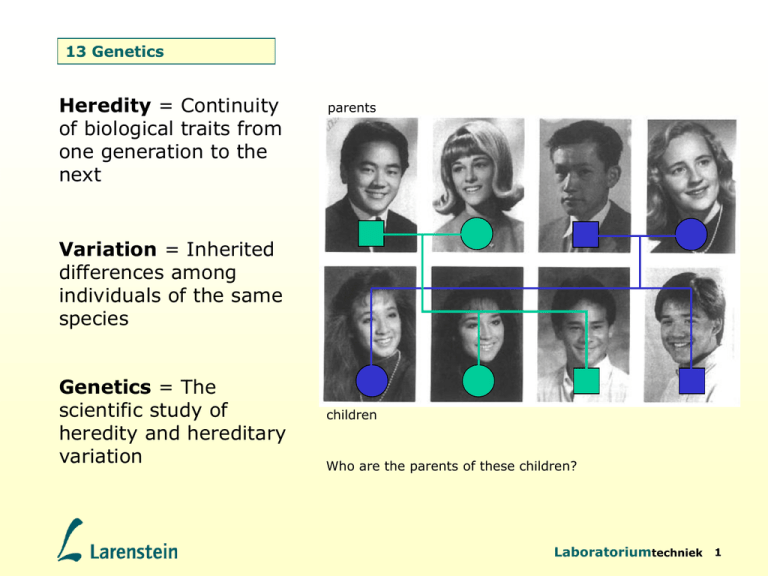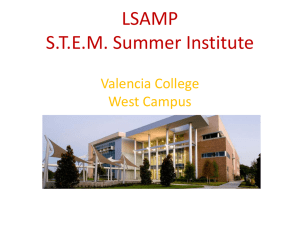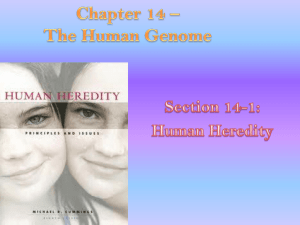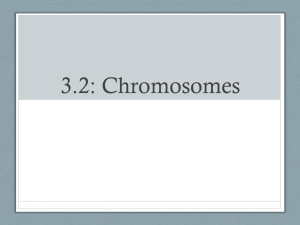
13 Genetics
Heredity = Continuity
of biological traits from
one generation to the
next
parents
Variation = Inherited
differences among
individuals of the same
species
Genetics = The
scientific study of
heredity and hereditary
variation
children
Who are the parents of these children?
Laboratoriumtechniek 1
13 Chromosome
Offspring acquire genes from
parents by inheriting
chromosomes
gene
locus
chromosome
DNA = Type of nucleic acid that
is a polymer of four different
kinds of nucleotides.
Chromosomes = Organizational
unit of heredity material in the
nucleus of eukaryotic organisms
Gene = Unit of hereditary
information that is made of DNA
and is located on chromosomes
Locus = Specific location on a
chromosome that contains a
gene
chromatine
wound on histon peptide
DNA double helix of nucleotides
base
pair
phosphate
desoxyribose
N-base
nucleotide
Laboratoriumtechniek 2
13 Karyotype
Laboratoriumtechniek 3
13 Asexual life cycle
Asexual reproduction
A type of reproduction
involving only one parent
that produces genetically
identical offspring by
budding or by the division
of a single cell or the
entire organism into two
or more parts
Laboratoriumtechniek 4
12 Mitosis l
Mitotic cell cycle:
In a dividing cell, the mitotic (M) phase alternates with interphase, a growth
period. The first part of interphase, called G1, is followed by the S phase,
when the chromosomes replicate; the last part of interphase is called G2. In
the M phase, mitosis divides the nucleus and distributes its chromosomes to
the daughter nuclei, and cytokinesis divides the cytoplasm, producing two
daughter cells.
Laboratoriumtechniek 5
12 Mitosis ll
Laboratoriumtechniek 6
12 Mitosis lll
Laboratoriumtechniek 7
13 Sexual life cycle
Meiosis and fertilization result
in alternation between the
haploid and diploid condition
Diploid = Condition in which cells
contain two sets (2n) of
chromosomes
Haploid = Condition in which cells
contain one set (1n) of chromosomes
Gamete = A haploid reproductive cell
(sperm cells and ova)
The diploid number is restored when
two haploid gametes unite
Fertilization = The union of two
gametes to form a zygote
Zygote = A diploid cell that results
from the union of two gametes
Laboratoriumtechniek 8
13 Variety of life cycles
Three basic patterns of
sexual life cycles
a. Animal
In animals gametes are the
only haploid cells
b. Fungi and some protists
In many fungi and some
protists, the only diploid stage
is the zygote
c. Plants and some algae
Plants and some species of
algae alternate between
multicellular haploid and diploid
generations
Laboratoriumtechniek 9
13 Life cycle malaria
Laboratoriumtechniek 10
13 Life cycle Aspergillus
Laboratoriumtechniek 11
13 (A)sexual reproduction
Like begets like, more or less: a comparison of asexual
versus sexual reproduction
Laboratoriumtechniek 12
13 Meiosis – overview
What happens during meiosis?
Laboratoriumtechniek 13
13 Meiosis l
Laboratoriumtechniek 14
13 Meiosis ll
Laboratoriumtechniek 15
13 Mitosis vs. meiosis
Laboratoriumtechniek 16
13 Origins of genetic variation l
1. Independent
assortment of
chromosomes
Independent assortment =
the random distribution
of maternal and paternal
homologues to the
gametes
The process produces 2n
possible combinations of
maternal and paternal
chromosomes in gametes
Laboratoriumtechniek 17
13 Origins of genetic variation ll
2. Crossing over
Crossing over = The exchange
of genetic material between
homologues; occurs during
prophase of meiosis I.
In humans, there is an average
of two or three crossovers
per chromosome pair
Laboratoriumtechniek 18
13 Origins of genetic variation lll
3. Random fertilization
Random fertilization is another
source of genetic variation in
offspring
The process produces 2n x 2n
possible combinations of
maternal and paternal
chromosomes in the zygote
4. Mutation
The ultimate source of
variation: random and
relatively rare structural
changes made during DNA
replication in a gene as a
result of mistakes
Laboratoriumtechniek 19
13 Summary
1. Offspring acquire genes from parents by inheriting
chromosomes
2. Like begets like, more or less
3.
4.
5.
6.
Fertilization and meiosis alternate in sexual life cycles
Meiosis reduces chromosome number from diploid to haploid
Sexual life cycles produce genetic variation among offspring
Evolutionary adaptation depends on a population’s genetic
variation
Laboratoriumtechniek 20
13 Key terms
heredity
zygote
variation
diploid cells
genetics
meiosis
gene
alternation of generations
asexual reproduction
clone
sporophyte
sexual reproduction
spores
fertilization
somatic cell
karyotype
meiosis I and II
homologous
synapsis
chromosomes
tetrad
sex chromosomes
chiasma (chiasmata)
autosome
gamete
crossing over
haploid cell
life cycle
gametophyte
syngamy
Laboratoriumtechniek 21
14 Heredity
Theories of heredity
Blending theory of heredity =
Pre-Mendelian theory of heredity proposing that hereditary
material from each parent mixes in the offspring; once
blended the hereditary material is inseparable and the
offspring's traits are some intermediate between the parental
types
Particulate theory of heredity = Gregor Mendel's theory that
parents transmit to their offspring discrete inheritable factors
(now called genes) that remain as separate factors from one
generation to the next
Laboratoriumtechniek 22
14 Mendel’s experiments
Terms
Character = Detectable inheritable
feature of an organism gene
Trait = Variant of an inheritable
character allele
True breeding = Always producing
offspring with the same traits as
the parents when the parents
are self-fertilized
P = true-breeding parental plants
of a cross
F1 = hybrid offspring of the Pgeneration
F2 = generation of self-pollinated
F1-plants
Laboratoriumtechniek 23
14 Monohybrid cross
Monohybrid cross
Hypothesis: If the inheritable factor
for white flowers had been lost,
then a cross between F1 plants
should produce only purpleflowered plants.
Experiment: Mendel allowed the F1
plants to self-pollinate.
Results: There were 705 purpleflowered and 224 white-flowered
plants in the F2 generation
— a ratio of 3:1.
Conclusion: The inheritable factor
for white flowers was not lost, so
the hypothesis was rejected
Laboratoriumtechniek 24
14 Testing hypotheses using the 2-statistic
There were 705 purple-flowered and
224 white-flowered plants in the
F2 generation.
Hypothesis: Is this a ratio of 3:1?
1. Calculate expected values based
on the result total (929):
3 : 1 = 696.75 : 232.25
2. Calculate the differences between
observed (O) and expected (E)
3. Standardise the differences:
|O – E |2
2
=
E
4. Calculate degrees of freedom (DF)
= number of differences – 1
5. Lookup in 2 table at DF
6. If p<0.05 then reject hypothesis
O
705
224
929
2
E
696.75
232.25
929
|O–E|
8.25
8.25
(8.25-0.5)2
(8.25-0.5)2
= +
696.75
232.25
The correction for continuity of
0.5 is only applied when DF=1
2 = 0.086 + 0.259 = 0.345
At DF=1 0.345 lies between 0.016
and 0.455 with 0.900>p>0.500,
so accept hypothesis
Laboratoriumtechniek 25
14 Law of segregation
By the law of segregation, the
two alleles for a character are
packaged into separate
gametes
1. Alternative forms of genes are
responsible for variations in
inherited characters.
2. For each character, an organism
inherits two alleles, one from
each parent.
3. If the two alleles differ, one is
fully expressed (dominant allele
P); the other is completely
masked (recessive allele p).
4. The two alleles for each character
segregate during gamete
production.
Laboratoriumtechniek 26
14 Genotype and phenotype
Homozygous = Having two
identical alleles for a given
trait (e.g., PP or pp).
Heterozygous = Having two
different alleles for a trait
(e.g., Pp).
Phenotype = An organism's
expressed traits (e.g., purple
or white flowers).
Genotype = An organism's
genetic makeup (e.g., PP,
Pp, or pp).
Laboratoriumtechniek 27
14 Testcross
Testcross = The breeding of an
organism of unknown
genotype with a
homozygous recessive
Laboratoriumtechniek 28
14 Dihybrid cross
Mendel's law of independent assortment = Each allele pair
segregates independently of other gene pairs during gamete
formation
Laboratoriumtechniek 29
14 Testing hypotheses using the 2-statistic
Laboratoriumtechniek 30
14 Laws of Probability
1. Rule of multiplication
Rule of multiplication = The
probability that
independent events will
occur simultaneously is the
product of their individual
probabilities
2. Rule of addition
Rule of addition = The
probability of an event that
can occur in two or more
independent ways is the
sum of the separate
probabilities of the different
ways
Question: In a Mendelian cross
between pea plants that are
heterozygous for flower color
(Pp), what is the probability
that the offspring will be
homozygous recessive?
Question: In a Mendelian cross
between pea plants that are
heterozygous for flower color (Pp),
what is the probability of the
offspring being a heterozygote?
Laboratoriumtechniek 31
14 Extended Mendelian genetics l
Incomplete dominance = dominant
phenotype is not fully expressed
in the heterozygote, resulting in
a intermediate phenotype
Complete dominance = an allele is
fully expressed in the phenotype
of a heterozygote and masks the
phenotypic expression of the
recessive allele;
the phenotypes of the
heterozygote and dominant
homozygote are indistinguishable
Codominance = full expression of
both alleles in the heterozygote
Laboratoriumtechniek 32
14 Extended Mendelian genetics ll
Important points about dominance/recessiveness relationships:
1. They range from complete dominance, through various
degrees of incomplete dominance, to codominance
2. They reflect the mechanisms by which specific alleles are
expressed in phenotype and do not involve the ability of one
allele to subdue another at the level of the DNA
3. They do not determine or correlate with the relative
abundance of alleles in a population
Laboratoriumtechniek 33
14 Extended Mendelian genetics lll
Multiple alleles = Some genes
may have more than just
two alternative forms of a
gene
Laboratoriumtechniek 34
14 Extended Mendelian genetics lV
Pleiotropy = The ability of
a single gene to have
multiple phenotypic effects
Epistasis = Interaction between
two nonallelic genes in which
one modifies the phenotypic
expression of the other (9:3:4)
Laboratoriumtechniek 35
14 Extended Mendelian genetics V
Polygenic inheritance = Mode of
inheritance in which the
additive effect of two or
more genes determines a
single phenotypic character
Laboratoriumtechniek 36
14 Nature versus nurture
• Norm of reaction = Range
of phenotypic variability
produced by a single
genotype under various
environmental conditions
• The expression of most
polygenic traits, such as
skin color, is multifactorial;
that is, it depends upon
many factors - a variety of
possible genotypes, as well
as a variety of
environmental influences
Laboratoriumtechniek 37
14 Human genetics
Humans are difficult to investigate
• long generation time
• few offspring
• experiments unacceptable
Pedigree = A family tree that diagrams the relationships among
parents and children across generations and that shows the
inheritance pattern of a particular phenotypic character
Laboratoriumtechniek 38
14 Human genetic disorders l
Recessive disorders:
• show up in
homozygous
individuals
• heterozygote are
called carriers
• frequencies differ
worldwide due to
local selective
forces
• Cystic fibrosis
Tay-Sachs disease
Sickle cell anemia
Laboratoriumtechniek 39
14 Human genetic disorders ll
Phenylketonuria
Dominant disorders
• Achondroplasia (dwarfism) 1:10,000 people
• Lethal dominant alleles are not passed to next generation
• Late-acting alleles escape elimination: Huntington’s disease
Multifactoral disorders (heart disease, diabetes, cancer,
schizophrenia)
Laboratoriumtechniek 40
14 Genetic testing
• Carrier recognition
• Fetal testing
• Newborn screening (PKU)
Laboratoriumtechniek 41
14 Summary
1. Mendel brought an experimental and quantitative approach to
genetics
2. By the law of segregation, the two alleles for a character are
packaged into separate gametes
3. By the law of independent assortment, each pair of alleles
segregates into gametes independently
4. Mendelian inheritance reflects rules of probability
5. Mendel discovered the particulate behavior of genes
6.
7.
8.
9.
The relationship between genotype and phenotype is rarely simple
Pedigree analysis reveals Mendelian patterns in human inheritance
Many human disorders follow Mendelian patterns of inheritance
Technology is providing news tools for genetic testing and
counseling
Laboratoriumtechniek 42
14 Key terms
character
polygenic inheritance
law of segregation
incomplete dominance
complete dominance
monohybrid cross
cystic fibrosis
multiple alleles
genotype
F2 generation
alleles
recessive allele
norm of reaction
codominance
phenotype
quantitative character
dominant allele
trait
true-breeding
multifactorial
homozygous
heterozygous
P generation
F1 generation
pleiotropy
testcross
dihybrid cross
hybridization
carriers
epistasis
sickle-cell disease
law of independent assortment
Laboratoriumtechniek 43
15 Chromosomal basis of inheritance
Chromosome theory of
inheritance:
Mendelian genes have
specific loci on
chromosomes, which
undergo segregation
and independant
assortment
Recombinants have new
combinations of traits
• RY and ry are parental
phenotypes
• rY and Ry are
recombinant
phenotypes
Laboratoriumtechniek 44
15 Morgan’s experiments with fruit flies l
Morgan used Drosophila melanogaster, a fruit fly species
• Short generation time
• Fruit flies have three pairs of autosomes and a pair of sex
chromosomes (XX in females, XY in males)
• The normal character phenotype is the wild type
• Alternative traits are mutant phenotypes
Laboratoriumtechniek 45
15 Morgan’s experiments with fruit flies ll
Cross white-eyed male with a redeyed female: F1 had red eyes
Crosses between the F1 offspring
produced the classic 3:1
phenotypic ratio in the F2
offspring
The white-eyed trait appeared only
in males
All the females and half the males
had red eyes
Morgan concluded that a fly’s eye
color is a sex-linked gene
Laboratoriumtechniek 46
15 Linked genes
• Dihybrid test cross
did not produce
1:1:1:1 ratio
genes must be on
the same
chromosome:
linked genes
• Complete linkage
gives ratio 1:1:0:0
• 17% recombinants
must be the result
of crossing over
Laboratoriumtechniek 47
15 Crossing over
Recombination is
result of crossing
over and
independant
assortment
Laboratoriumtechniek 48
15 Genetic maps
Geneticists can use
recombination data to
map a chromosome’s
genetic loci:
linkage map
The farther apart two
genes are, the higher
the probability that a
crossover will occur
between them and
therefore a higher
recombination
frequency
•
The recombination frequency
between cn and b is 9%
•
The recombination frequency
between cn and vg is 9.5%
•
The recombination frequency
between b and vg is 17%
•
How are the loci arranged?
b – vg – cn
or
vg – b - cn
Map distance: 1 unit is
1% recombination
Laboratoriumtechniek 49
15 Genetic maps
Why is 9,0 (b-cn)+ 9,5 (cn-vg) > 17% (b-vg)?
This results from multiple crossing over:
the further loci are apart, the greater
the change for multiple crossing over
events
Some genes on a chromosome are so far
apart that a crossover between them
is virtually certain: independent
inheritance, no linkage
Laboratoriumtechniek 50
15 Sex chromosomes
Laboratoriumtechniek 51
Summary
1. Mendelian inheritance has its physical basis in the behavior of
chromosomes during sexual life cycles
2. Morgan traced a gene to a specific chromosome
3. Linked genes tend to be inherited together because they are located on
the same chromosome
4. Independent assortment of chromosomes and crossing over produce
genetic recombinants
5. Geneticists use recombination data to map a chromosome’s genetic loci
6. The chromosomal basis of sex varies with the organism
7. Sex-linked genes have unique patterns of inheritance
8. Alterations of chromosome number or structure cause some genetic
disorders
9. The phenotypic effects of some mammalian genes depend on whether
they are inherited from the mother or the father (imprinting)
10.Extranuclear genes exhibit a non-Mendelian pattern of inheritance
Laboratoriumtechniek 52
15 Key terms
chromosome theory of inheritance
polyploidy
deletion
duplication
hemophilia
sex-linked genes
translocation
nondisjunction
genetic recombination
fragile X syndrome
trisomic
monosomic
linkage map
cytological map
wild type
mutant phenotype
inversion
Barr body
linked genes
Down syndrome
aneuploidy
parental type
recombinants
Laboratoriumtechniek 53
18 Genetics of viruses and bacteria
• Bacteria are prokaryotic
organisms:
- small
- no compartments
- single, circular chromosome
• Viruses are smaller and
simpler still, lacking the
structure and most metabolic machinery in cells
- aggregates of nucleic acids
and protein
- genes in a protein coat
- reproduce in host-cells
- limited hoste-range
• Ideal genetic models for study
Laboratoriumtechniek 54
18 Discovery of viruses
The discovery of Tobacco Mosaic Virus TMV
1939
Ultimate pathogen test: Postulates of Koch
1886 Mayer: very small, invisible, nonculturable bacterium?
1892 Ivanowsky: pathogen passed porcelain
filter – small bacterium or toxin?
1898 Beijerinck: infectious agent reproduces
in living host, is soluble, not killed in
ethanol – named micro-organism virus
1935 Stanley: crystallized the pathogen
1939 Kaushe et al: first electron micrograph,
particle is only 20 nm in diameter
TMV particle consists of nucleic acid enclosed
by a protein coat
today
Laboratoriumtechniek 55
18 Viral structure
1 Viral genome
• ds DNA, ss DNA, ds RNA or ss RNA
• Single nucleic acid molecules that
are linear or circular
• May have four to hundreds of
genes
2 Capsids
• Capsid = Protein coat that
encloses the viral genome,
composed of many capsomeres
• Nucleocapsid = integrated
structure of nucleic acid and
capsid-proteins
Laboratoriumtechniek 56
18 Viral structure
3 Envelopes or membranes
• Envelope = Membrane that
cloaks some viral capsids
• Helps viruses infect their host
by fusing with cell-membrane
• Derived from host cell or
nuclear membrane which is
usually virus-modified
• They also have some viral
proteins and glycoproteins
Laboratoriumtechniek 57
18 Bacteriophages
• The most complex capsids are
found among bacteriophages
• Of the first phages studied, seven
infected E. coli. These were named
types 1 – 7 (T1, T2, T3, ... T7).
• The T-even phages – T2, T4, and
T6—are structurally very similar
• The icosohedral head encloses the
genetic material
• The protein tailpiece with tail fibers
attaches the phage to its bacterial
host and injects its DNA into the
bacterium
Laboratoriumtechniek 58
18 Infection cycle
• Viral infection begins when
virus genome enters the host
cell
• Once inside, the viral
genome commandeers its
host, reprogramming the cell
to copy viral nucleic acid and
manufacture proteins from
the viral genome
• Nucleic acid molecules and
capsomeres self-assemble
into viral particles that exit
the cell
Laboratoriumtechniek 59
18 Phage lytic cycle
In the lytic cycle the phage kills the host. Virus is called virulent.
Laboratoriumtechniek 60
18 Defenses against phages
• Natural selection favors bacterial mutants with receptors sites
that are no longer recognized by a particular type of phage
• Bacteria produce restriction nucleases that recognize and cut
up foreign DNA, including certain phage DNA
Modifications to the bacteria’s own DNA prevent its
destruction by restriction nucleases
• But, natural selection favors resistant phage mutants.
Laboratoriumtechniek 61
18 Phage lysogenic cycle
In the lysogenic cycle phage DNA incorporates in bacterial DNA:
prophage. Virus is called temperate.
Laboratoriumtechniek 62
18 Replication strategies in plant and animal viruses
• –RNA and retroviruses have viral enzymes in nucleocapside
• RNA-viruses have high mutation rates (no proof-reading
during replication)
Laboratoriumtechniek 63
18 Animal viruses
Laboratoriumtechniek 64
18 Retrovirus
• HIV causes AIDS (Acquired Immuno Deficiency Syndrome)
• HIV is a retrovirus
Laboratoriumtechniek 65
18 Viruses and symptoms
• The link between viral infection and the symptoms it produces
is often obscure
– Virus triggers release of hydrolytic enzymes from lysosomes
– Viruses causes the infected cell to produce toxins that lead
to disease symptoms
– Virus has toxic molecular components (envelope proteins)
• In some cases, viral damage is easily repaired (respiratory
epithelium after a cold), but in others, infection causes
permanent damage (nerve cells after polio)
• Cure by immune system, some medicines:
– AZT interferes with reverse transcriptase of HIV
– Acyclovir inhibits herpes virus DNA synthesis
– antibiotics are useless
• Prevention by vaccination
• RNA-viruses are hard to combat, because they mutate fast
• Disease
• Cause major losses
Laboratoriumtechniek 66
18 Plant viruses l
Plant viruses are classified
according to ICTV
guidelines:
The Current Classification of Plant
Virus Genera*
• Type of nucleid acid
• Form
• Host
*abstract
Laboratoriumtechniek 67
18 Plant viruses ll
Plant viral diseases are spread by two major routes:
• Horizontal transmission: infection by an external source
– Plants are more susceptible if their protective epidermis is
damaged, perhaps by wind, chilling, injury, or insects.
– Insects are often carriers of viruses, transmitting disease
from plant to plant
non-persistent: insect is infectious for short time
persistent: insect remains infectious for long period or forever
(propagates in insect)
• Vertical transmission: a plant inherits a viral infection from a
parent
– This may occur by asexual propagation or in sexual
reproduction via infected seeds
Laboratoriumtechniek 68
18 Plant viruses lll
• Once it starts reproducing inside a plant cell, virus particles
can spread throughout the plant by passing through
plasmodesmata
• Agricultural scientists have focused their efforts largely on
reducing the incidence and transmission of viral
disease and in breeding resistant plant varieties
Laboratoriumtechniek 69
18 Where did viruses come from?
• Candidates for the original sources of viral genomes include
plasmids and transposons
– Plasmids are small, circular DNA molecules that are
separate from chromosomes
– Plasmids, found in bacteria and in the eukaryote yeast,
can replicate independently of the rest of the cell and are
occasionally be transferred between cells
– Transposons are DNA segments that can move from one
location to another within a cell’s genome
• Both plasmids and transposons are mobile genetic elements
Laboratoriumtechniek 70
18 Viroids
• Viroids, smaller and simpler than even viruses, consist of tiny
molecules of naked circular RNA that infect plants
Potato spindle tuber viroid
• Their several hundred nucleotides do not encode for proteins
but can be replicated by the host’s cellular enzymes
• These RNA molecules can disrupt plant metabolism and stunt
plant growth, perhaps by causing errors in the regulatory
systems that control plant growth
Laboratoriumtechniek 71
18 Prions
• Prions are infectious proteins that spread a disease
They appear to cause several degenerative brain
diseases including scrapie in sheep, “mad cow
disease”, and Creutzfeldt-Jacob disease in
humans
• According to the leading hypothesis, a prion is a
misfolded form of a normal brain protein
• It can then convert a normal protein into the prion
version, creating a chain reaction that increases
their numbers
normal
disease-causing
Laboratoriumtechniek 72
18 Bacteria l
• The short generation span of
bacteria helps them adapt to
changing environments
• Genetic recombination
produces new bacterial strains
• The control of gene expression
enables individual bacteria to
adjust their metabolism to
environmental change
• Bacteria are haploid:
mutations are immediately
expressed
Laboratoriumtechniek 73
18 Bacteria ll
• The major component of the bacterial
genome is one double-stranded, circular
DNA molecule
– For E. coli, the chromosomal DNA
consists of about 4.6 million nucleotide
pairs with about 4,300 genes.
– This is 100 times more DNA than in a
typical virus and 1,000 times less than in
a typical eukaryote cell
– Tight coiling of the DNA results
in a dense region of DNA, called
the nucleoid, not bounded by
a membrane
• In addition, many bacteria have
plasmids, much smaller circles of DNA
– Each plasmid has only a small number of
genes, from just a few to several dozen
Laboratoriumtechniek 74
18 Replication
• Bacterial cells divide
by binary fission
• This is preceded by
replication of the
bacterial chromosome
from a single origin of
replication: rolling
circle model
Laboratoriumtechniek 75
18 Replication
• Bacteria proliferate very rapidly in a favorable natural or
laboratory environment
– E. coli can divide every 20 minutes, producing a colony of 107
to 108 bacteria in as little as 12 hours
– In the human colon, E. coli reproduces rapidly enough to
replace the 2 x 1010 bacteria lost each day in feces
• Through binary fission, most of the bacteria in a colony are
genetically identical to the parent cell
– However, the spontaneous mutation rate of E. coli is 1 x 10-7
mutations per gene per cell division
– This will produce about 2,000 bacteria in the human colon that
have a mutation in that gene per day
– New mutations, though individually rare, can have a
significant impact on genetic diversity
– Individual bacteria that are genetically well equipped for the
local environment outgrow less fit individuals
Laboratoriumtechniek 76
18 Recombination
• Recombination is the combining of DNA from two individuals
into a single genome generates diversity
• Recombination occurs through three processes:
– Transformation
– Transduction
– Conjugation
Laboratoriumtechniek 77
18 Transformation l
• Transformation is the alteration of a bacterial cell’s genotype
by the uptake of naked, foreign DNA from the surrounding
environment
Discovered by Griffith in 1928.
Laboratoriumtechniek 78
18 Transformation ll
• Many bacterial species have surface proteins that are
specialized for the uptake of naked DNA
– These proteins recognize and transport only DNA from
closely related bacterial species
– While E. coli lacks this specialized mechanism, it can be
induced to take up small pieces of DNA if cultured in a
medium with a relatively high concentration of calcium
ions
– In biotechnology, this technique has been used to
introduce foreign DNA into E. coli
Laboratoriumtechniek 79
18 Transduction l
Laboratoriumtechniek 80
18 Generalised transduction
• Transduction occurs when a phage carries bacterial genes
from one host cell to another
• In generalised transduction, a small piece of the host cell’s
degraded DNA is packaged within a capsid, rather than the
phage genome
– These proteins recognize and transport only DNA from
closely related bacterial species
– When this pages attaches to another bacterium, it will
inject this foreign DNA into its new host
– Some of this DNA can subsequently replace the
homologous region of the second cell
– This type of transduction transfers bacterial genes at
random
Laboratoriumtechniek 81
18 Specialised transduction
• Specialized transduction occurs via a temperate phage
– When the prophage viral genome is excised from the
chromosome, it sometimes takes with it a small region of
adjacent bacterial DNA
– These bacterial genes are injected along with the phage’s
genome into the next host cell
– Specialized transduction only transfers those genes near
the prophage site on the bacterial chromosome
• Both generalized and specialized transduction use phage as a
vector to transfer genes between bacteria
Laboratoriumtechniek 82
18 Conjugation
• Conjugation transfers genetic material between two bacterial
cells that are temporarily joined
• One cell (“male”) donates DNA and its “mate” (“female”)
receives the genes
• A sex pilus from the male initially joins the two cells and
creates a cytoplasmic bridge between cells
• “Maleness,” the ability to form
a sex pilus and donate DNA,
results from an F factor as a
section of the bacterial
chromosome or as a plasmid
Laboratoriumtechniek 83
18 Plasmids
• Plasmids, including the F plasmid, are small, circular, selfreplicating DNA molecules
• Episomes, like the F plasmid, can undergo reversible
incorporation into the cell’s chromosome
– Temperate viruses also qualify as episomes.
• Plasmids generally benefit the bacterial cell
• They usually have only a few genes that are not required for
normal survival and reproduction
– Plasmid genes are advantageous in stressful conditions
– The F plasmid facilitates genetic recombination when
environmental conditions no longer favor existing strains
– Many plasmids carry antibiotic resistance
Laboratoriumtechniek 84
18 Conjugation ll
• The F factor or its F plasmid consists of about 25 genes,
most required for the production of sex pili
– Cells with either the F factor or the F plasmid are called
F+ and they pass this condition to their offspring
– Cells lacking either form of the F factor, are called F-, and
they function as DNA recipients
• When an F+ and F- cell meet, the F+ cell passes a copy of the
F plasmid to the F- cell, converting it into an F+ cell
Laboratoriumtechniek 85
18 Conjugation lll
• The plasmid form of the F factor can become integrated into
the bacterial chromosome
• The resulting Hfr cell (high frequency of recombination)
functions as a male during conjugation
Laboratoriumtechniek 86
18 Conjugation lV
• The Hfr cell initiates DNA replication at a point on the F factor
DNA and begins to transfer the DNA copy from that point to
its F- partner
• In the partially diploid cell, the newly acquired DNA aligns
with the homologous region of the F- chromosome
• Recombination exchanges segments of DNA
Laboratoriumtechniek 87
18 R Plasmids
• In the 1950s, Japanese physicians began to notice that some
bacterial strains had evolved antibiotic resistance
– The genes conferring resistance are carried by plasmids,
specifically the R plasmid (R for resistance)
– Some of these genes code for enzymes that specifically
destroy certain antibiotics, like tetracycline or ampicillin
• When a bacterial population is exposed to an antibiotic,
individuals with the R plasmid will survive and increase in the
overall population
• Because R plasmids also have genes that encode for sex pili,
they can be transferred from one cell to another by
conjugation
Laboratoriumtechniek 88
18 Key terms
capsid
transformation
prophage
viral envelope
transduction
bacteriophage (phage)
conjugation
host range
F factor
lytic cycle
episome
virulent
vaccine
lysogenic cycle
provirus
temperate virus
prion
retrovirus
plasmodesma(ta)
reverse transcriptase
nucleoid
HIV
virion
AIDS
R plasmid
virus
F plasmid
Laboratoriumtechniek 89
Osmosis
•
•
Water potential
=R.T.i.M.10–3 Mpa
total= pressure + solutes
Laboratoriumtechniek 90
Koch’s postulates
1. The microorganism should be shown to be present in all cases
of animals suffering from a specific disease but shold not be
found in healthy animals
2. The specific microorganism should be isolated from the
diseased animal and grown in pure culture on artificial
laboratory media
3. This freshly isolated microorganism, when inoculated into a
healthy laboratory animal, should cause the same disease
seen in the original animal
4. The microorganism should be reisolated in pure culture from
the experimental infection
Laboratoriumtechniek 91
the 2-statistic
Laboratoriumtechniek 92










